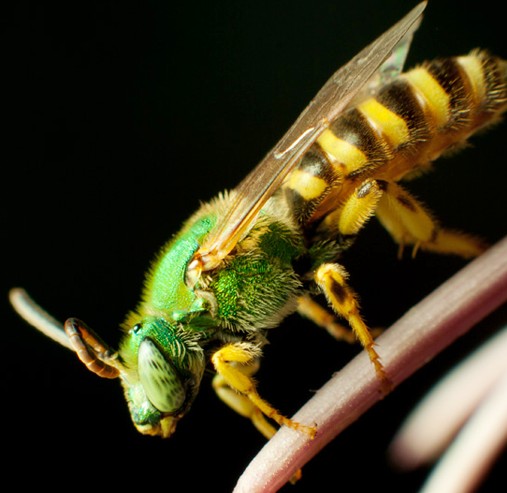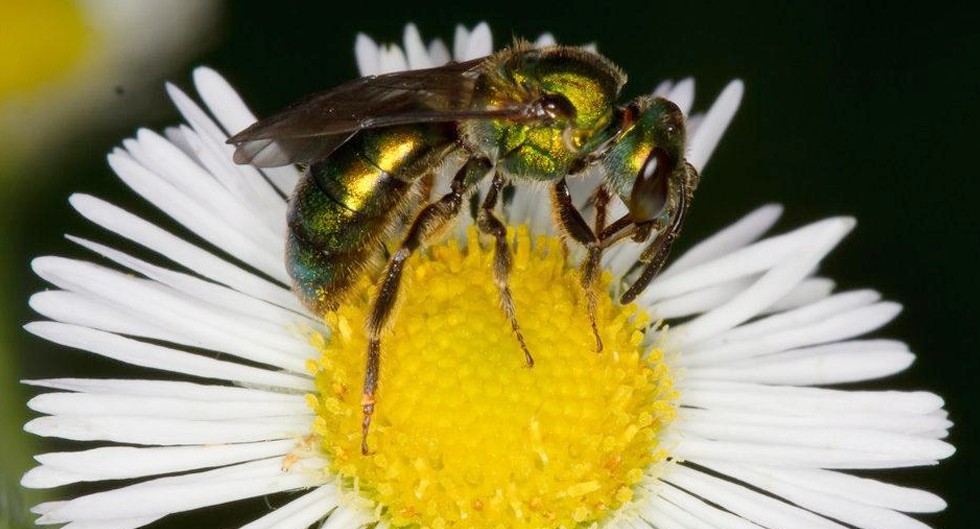Sweat Bee
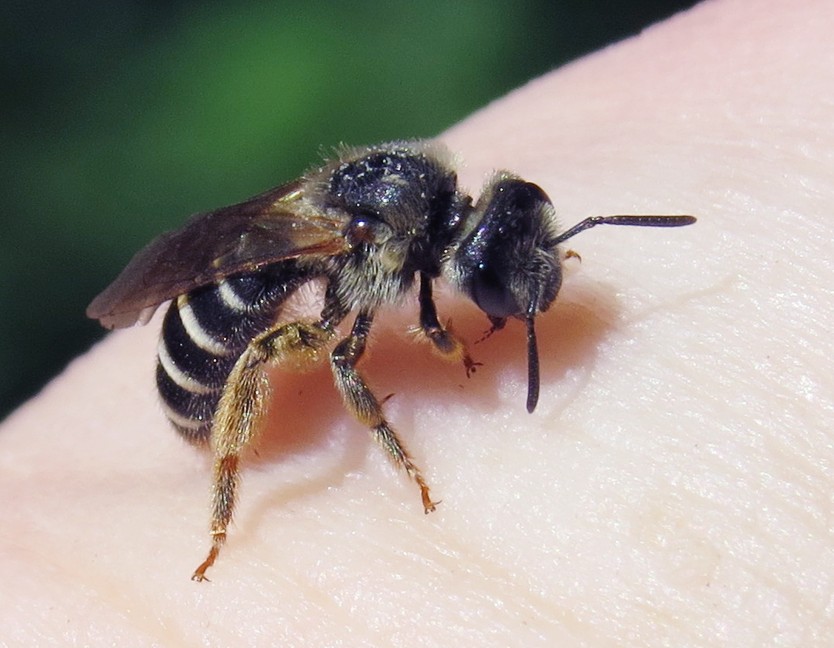
Picture of a Sweat bee
What is a Sweat Bee?
These metallic colored bees are found all over the world except in Australia and South-East Asia and are called Halictidae. However, due to their attraction towards human perspiration, they are not-so-fondly known as ‘sweat bees.’ This obviously can get very annoying for people wanting to relax in the garden or elsewhere, especially during summers.
Please note that because sweat bees have a tiny size, they are often confused with the common house flies or wasps. In terms of population, the Sweat Bees rank second, losing the first position to the mighty Honey Bees.
Appearance: What do Sweat Bees look like?
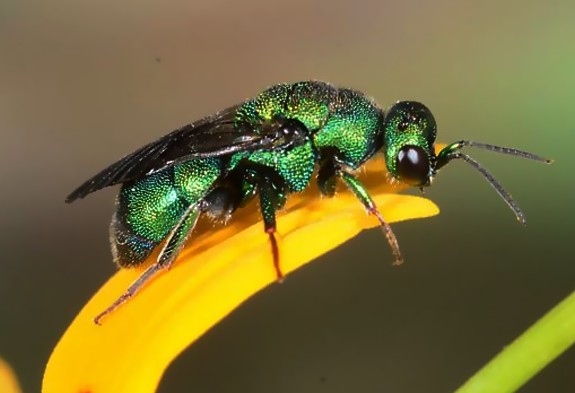
Sweat bees belong to the Halictidae family, and there are more than 4300 subspecies in this category alone. Sweat bees are tiny creatures ranging from about 4mm to 8mm only. They have three body parts; the head, the thorax, and the abdomen. One of the prominent features of the sweat bees is that they all have a yellow face, though their bodies may be green, brown, black, metallic or red in color. They also have hind legs full of hair, which leads to them being mistaken for as bumble bees.
Behavior of Sweat bees
Honey bees are known to produce honey and build their nests in attics and wall voids. The Sweat bees don’t do any of that. Sweat bees make their nests on the ground mostly, while some of them build their homes in rotten wood. You can spot such nests inside hollow trunks, or underground too.
While most Sweat bees live in solidarity in underground nests, there are also some of them that live together by building nests in groups. Sweat bees make nests that can hold only one queen bee at a time, but sometimes they have more than one queen bee who stay in the same hive, but in separate cells.
What do Sweat bees eat?
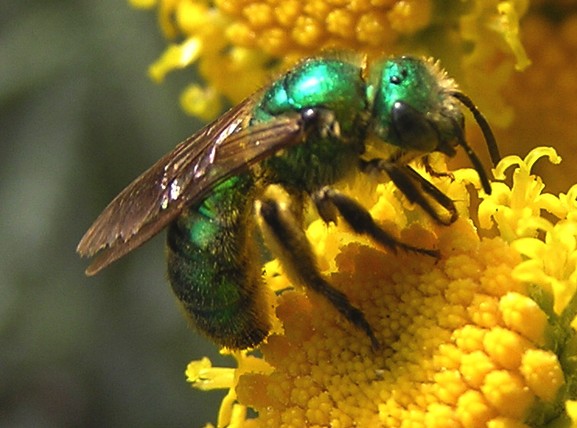
Picture of a sweat bee eating
Sweat bees though are lured by the salt found in human sweat, they actually eat nectar and pollen found in flowers, and also qualify to be significant pollinators among the plant species. They also gather pollen in large quantity and store them for their baby bees.
The larvae that develops in the nests that are built underground, eat from the pollen and nectar that the bees had provided after they laid eggs there. Just like the athletes drink beverages containing electrolytes to boost their energy and to supplement their diet with salts, even bees do the same by trying to obtain salt from human sweat.
Do the Sweat bees Sting or Bite?
Well, Sting bees are mostly docile, and they are not known to be aggressive. But yes, if they feel threatened or they can sense an attack, then they may sting. However, you can’t really call that a sting you know? These sweat bees are so tiny, and they have such short tongues that they’re good enough to lick human sweat only. Even if they do bite you, be rest assured, it will not be very painful. The Schmidt Sting Pain Index reveals that a sweat bees sting is the least painful when compared to all other stinging insects.
Also, you’d be surprised to know, the male bees never sting. It is only the female bees that are known to mildly sting you when you try to swat them away, or when they feel aggravated. The Sweat bees deliver only mild stings that are painless, but they mostly swarm in hundreds to attack, which can be dangerous.
How to treat Sweat bee sting?
Though the sting is mild, the stinger may continue injecting venom for a long, long time. Therefore, it becomes necessary to remove the stinger from where the bee has bitten you. Try and scrape the stinger out of your skin by using a nail file or the edge of your debit/credit cards and gently push it out of your skin. Remember not to pinch the sting with your hand because it will accelerate the release of venom even further.
Also, you should wash the affected area with water and soap and follow it up by using a cold compress to reduce the swelling. If you experience irritation in the affected area, a hydrocortisone cream applied topically can help to soothe the area. Alternatively, you could apply a paste of baking soda and water to heal the area.
Are Sweat bees advantageous or harmful to the environment?
Not just sweat bees, but all types of bees are vital to our ecosystem. They help in sustaining a variety of plant species by carrying out pollination amidst vegetation that expands to large distances. In this way, they keep the vegetation lively. There are many who strive to keep the bees alive and help them breed because the bees accelerate the growth of their crops and garden vegetation indirectly.
Did you know, the population of bees has dropped dramatically recently? You should not try to harm the bees unnecessarily as that can threaten their population further. The ‘Colony Collapse Disorder’ has affected some of the bee species in a gruesome manner due to increasing pollution and rising toxins found in the soil.
FYI, Colony Collapse Disorder or CCD is a situation when the queen is left behind in the colony alone, with abundant food and a few nurse bees to cater for the remaining immature bees and the worker bees all disappear in majority.
Sweat bees only help our environment and do not damage it under any case. You should also strive to protect the bees.
What is their human and ecosystem connection like?
Why they have earned that infamous name of being termed as ‘sweat bees’ is because of the bees’ tendency to sit on humans with the intention to lick their salty sweat, and also get moisture from the perspiration. Though you can easily shoo them away with a gentle scrape, if it’s a female bee, it may attack you with a mild sting in defense. Don’t worry, as we said, they’re painless.
One strange behavior of sweat bees is that they qualify to be stealers. Yes, some sweat bees fall under the category of insects that show the behavior of ‘kleptoparasitism’ where klepto means stealing. There are some sweat bees that sneak into other bees’ species’ nests, eat the owners’ eggs, and replace them with their own laid eggs after having the food provided for the eggs. Kleptoparasites tend to depend on their hosts for all their life.
How can you get rid of the Sweat Bees?
Because sweat bees are attracted to humans due to their sweat, it is ideal to take some preventive measures. You could use a DIY spray as a repellent to knock off the bees. All you need to do is fill one-fourth of the bottle with dish soap and the remaining with water and target on the bees to keep them away. You could also rub peppermint oil or tea tree oil on your skin as the smell helps to repel the bees.
You should also avoid using strong perfumes as they attract the bees. Dry and exposed soil is where these bees breed, so you should remember to keep the exposed soil covered. Also, don’t forget to keep away dead wood where the bees are likely to build nests.
Even if you own treeless and well-lit yards, you may experience bees’ infestation in your area. In such a case, you should contact professional pest controllers to curb the problem.
Interesting facts about Bees in general
- Any habitat on the planet that supports flowering plants which are insect-pollinating has bees. This makes Antarctica a place where you can’t spot bees in most numbers.
- It has been revealed that there are more than 20,000 species of bees on the planet.
- You know why bees make honey? It is to feed their young ones, especially during winter.
- There are some bees that die after stinging. This is because their stingers have a little hook on them attached to their stomach. Sadly, part of their abdomen is ripped apart when they try to fly away post-stinging.
- Bees vary in sizes. While the smallest one Euryglossina (Quasihesma) measures only 2mm, the largest one Megachile/Chalicodoma pluto, is about 4cm long.
- FYI, only a few species of bees make honey; not all ‘Killer bees’ look like honey bees; the difference being the size of their wings. They got that name because they attack humans after coming together in a large group, which can be dangerous.
- From the Bumblebee Conservation Trust in the UK, Richard Comont has said, “No male bee of any species can sting, even honeybees and bumblebees. Only the female ones have that power. Whoa!
- In Spain, some rock paintings that date back to the 15,000 BC have bees in them.
- Honey-making species of bees do their own ‘waggle’ dance as a form of communication.
Until now, whenever you heard the word ‘bee,’ you could picture only Honey Bees, right? Having read this article, now you can not only identify, but you also have so much information about the ‘Sweat Bees’! We know they are annoying, but hey, at least they don’t sting that bad! He-he!
Picture of Sweat bees
Here are some of the pictures of sweat bees…
